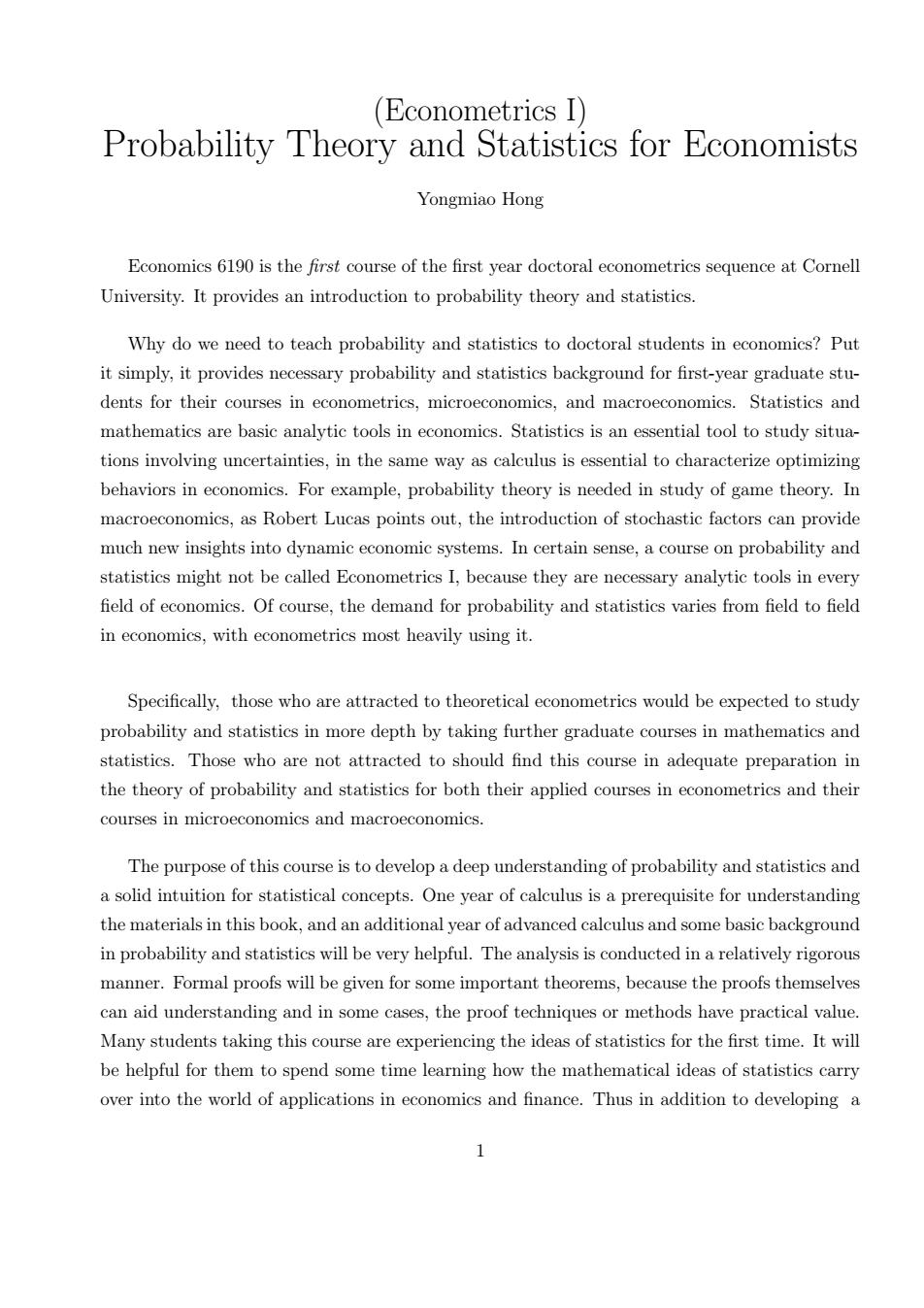正在加载图片...

(Econometrics I) Probability Theory and Statistics for Economists Yongmiao Hong Economics 6190 is the first course of the first year doctoral econometrics sequence at Cornell University.It provides an introduction to probability theory and statistics. Why do we need to teach probability and statistics to doctoral students in economics?Put it simply,it provides necessary probability and statistics background for first-year graduate stu- dents for their courses in econometrics,microeconomics,and macroeconomics.Statistics and mathematics are basic analytic tools in economics.Statistics is an essential tool to study situa- tions involving uncertainties,in the same way as calculus is essential to characterize optimizing behaviors in economics.For example,probability theory is needed in study of game theory.In macroeconomics,as Robert Lucas points out,the introduction of stochastic factors can provide much new insights into dynamic economic systems.In certain sense,a course on probability and statistics might not be called Econometrics I,because they are necessary analytic tools in every field of economics.Of course,the demand for probability and statistics varies from field to field in economics,with econometrics most heavily using it. Specifically,those who are attracted to theoretical econometrics would be expected to study probability and statistics in more depth by taking further graduate courses in mathematics and statistics.Those who are not attracted to should find this course in adequate preparation in the theory of probability and statistics for both their applied courses in econometrics and their courses in microeconomics and macroeconomics. The purpose of this course is to develop a deep understanding of probability and statistics and a solid intuition for statistical concepts.One year of calculus is a prerequisite for understanding the materials in this book,and an additional year of advanced calculus and some basic background in probability and statistics will be very helpful.The analysis is conducted in a relatively rigorous manner.Formal proofs will be given for some important theorems,because the proofs themselves can aid understanding and in some cases,the proof techniques or methods have practical value. Many students taking this course are experiencing the ideas of statistics for the first time.It will be helpful for them to spend some time learning how the mathematical ideas of statistics carry over into the world of applications in economics and finance.Thus in addition to developing a(Econometrics I) Probability Theory and Statistics for Economists Yongmiao Hong Economics 6190 is the first course of the first year doctoral econometrics sequence at Cornell University. It provides an introduction to probability theory and statistics. Why do we need to teach probability and statistics to doctoral students in economics? Put it simply, it provides necessary probability and statistics background for first-year graduate students for their courses in econometrics, microeconomics, and macroeconomics. Statistics and mathematics are basic analytic tools in economics. Statistics is an essential tool to study situations involving uncertainties, in the same way as calculus is essential to characterize optimizing behaviors in economics. For example, probability theory is needed in study of game theory. In macroeconomics, as Robert Lucas points out, the introduction of stochastic factors can provide much new insights into dynamic economic systems. In certain sense, a course on probability and statistics might not be called Econometrics I, because they are necessary analytic tools in every field of economics. Of course, the demand for probability and statistics varies from field to field in economics, with econometrics most heavily using it. Specifically, those who are attracted to theoretical econometrics would be expected to study probability and statistics in more depth by taking further graduate courses in mathematics and statistics. Those who are not attracted to should find this course in adequate preparation in the theory of probability and statistics for both their applied courses in econometrics and their courses in microeconomics and macroeconomics. The purpose of this course is to develop a deep understanding of probability and statistics and a solid intuition for statistical concepts. One year of calculus is a prerequisite for understanding the materials in this book, and an additional year of advanced calculus and some basic background in probability and statistics will be very helpful. The analysis is conducted in a relatively rigorous manner. Formal proofs will be given for some important theorems, because the proofs themselves can aid understanding and in some cases, the proof techniques or methods have practical value. Many students taking this course are experiencing the ideas of statistics for the first time. It will be helpful for them to spend some time learning how the mathematical ideas of statistics carry over into the world of applications in economics and finance. Thus in addition to developing a 1